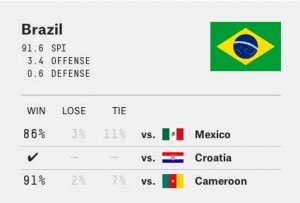News organizations around the globe have been bringing their A game to coverage of the World Cup 2014. The quadrennial event has prompted the production of some whip smart interactives, quirky videos and other innovative forms of journalism.
This focus on quality makes sense. For an event covered by practically every news organization in the world, producing something special is the best way to get attention from a global audience.
Here are nine of our favorites:
1) A Goal, from 11 Perspectives: The New York Times expertly captured how different groups of people in 11 different locations reacted to host country Brazil’s first goal scored in the first game of the 2014 World Cup (in a 3-1 victory over Croatia). As the user scrolls down, video plays continuously, showing the range of reactions in quick succession from each location – everything from the wild dancing at a colorful party in Salvador to the jubilance of one man and his co-worker at a security desk in Rio.
2) World Cup Moments Recreated, Using Legos: Here’s a good idea: Make childhood toys tell the stories of the World Cup. The Guardian’s “Brick-by-brick” animation series does just that with Legos, bringing the games to life with little Lego guys who energetically score goals and celebrate together. It’s very cute to see Argentinian Diego Maradona’s “Hand of God” goal against England in 1986 and Lego man Zinedine Zidane (of France) headbutt an Italian player in the 2006 final.

Look at the Lego guys playing soccer! Aren’t they cute? Screenshot from The Guardian’s Brick-by-brick series.
3) A Clickable Animated Comic Book: This hilariously smart New York Times Magazine piece, written by Christoph Niemann with Jon Huang as the developer, tells the story of one particularly agonizing World Cup loss by Brazil and how it has haunted the country for decades. The animated feature lets the user click through photos of the stunning vistas and architecture of Brazil with juxtaposed illustrations that tell the story of the country’s upset loss to Uruguay in the 1950 World Cup final and the man responsible for it.
4) A Scrolling History of Alcoholic Beverages: An original feature on Digg.com explores the alcoholic beverages of choice from the 32 countries in the tournament, with fascinating results. For example, Matango in Cameroon is a “sweet boozy beverage made from palm sap,” and Alomo is what people in Nigeria drink as an aphrodisiac. The author writes: “Personally, we don’t play favorites so we’ll be imbibing all of these drinks in equal measure. See you in the hospital!”
5) Visualized Predictions – And Results: Bloomberg Visual Data created a beautiful interactive chart, featuring predictions for the outcome of every World Cup match — including the score and probability of victory — through the final. The fact that it calls for Spain — which looked horrible against the Netherlands in their opening match — to reach the final suggests its predictions should be looked at critically. Thankfully, it allows users to input their own predictions for the outcome of each match.
6) An International, Interactive Historical Guide to World Cup Uniforms: This Guardian feature allows users to look back at the uniforms worn by each team in the tournament in past World Cups. Hot: Germany 2010, Ghana 2014, Italy 2002, Netherlands 2014, Brazil, 2006, Croatia 2006. Not: Spain 1994, Germany 1994, Belgium 1982, Argentina 2002, Iran 1998, Portugal 2014.
7) Nate Silver’s Forecasting Model: Nate Silver, the witch who correctly predicted both of Barack Obama’s presidential election victories, has brought his analytical powers to bear on what some may see as an event of even greater global significance. His site, FiveThirtyEight.com, has a smartly designed interactive that forecasts the outcome of the tournament using the Soccer Power Index that Silver developed for ESPN. It’s being updated as the tournament progresses and, after Spain’s first round loss, smartly predicts that they will fail to exit the group stage.
8) World Cup for Dummies. The Onion’s new Clickhole.com, which satirizes clickbait, offers information for viewers who are watching only at a casual level. In its “10 Kicks You Should Know About Before You Watch the World Cup,” writers included the famous “far kick” and the lesser known, but still important, “kick to another player.”

The Onion’s Clickhole.com educates the casual World Cup viewer on kicks. Screenshot from Clickhole.com
9) Deadspin’s extreme slow-motion video of Cristiano Ronaldo’s crying face, set to the soundtrack of indie music. Just watch it. You’ll be glad you did.















Leave a Comment